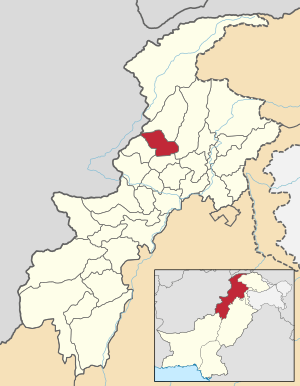Lower Dir District facts for kids
Lower Dir (Pashto: لر دیر , Urdu: دیر زیریں) is a district in the Khyber Pakhtunkhwa province of Pakistan. It is located in the northwestern part of the province. The district covers an area of about 1,583 square kilometers. The main city and district headquarters is Timergara.
Lower Dir used to be part of a larger district called Dir. In 1996, it was divided into two separate districts: Upper Dir and Lower Dir.
Contents
History of Lower Dir
When Pakistan became an independent country in 1947, Dir was a special area ruled by a local leader called Nawab Shah Jehan Khan. This area was joined with Pakistan in 1969. A year later, in 1970, it was officially made a district. Later, in 1996, the Dir district was split into two parts: Lower Dir and Upper Dir.
Geography of Lower Dir
Much of Lower Dir is covered by mountains. Some of these mountains are very tall, reaching heights of up to 5,000 meters (about 16,400 feet).
People of Lower Dir
According to a count in 1998, the population of Lower Dir district was around 797,852 people. By 2005, it was estimated that the population had grown to over 1 million people.
How Lower Dir is Governed
Lower Dir is divided into smaller areas called Tehsils. These Tehsils help manage the district more easily. There are seven Tehsils in Lower Dir, and they are further divided into 41 smaller areas called union councils.
Some of the main Tehsils include:
- Adenzai
- Balambat
- Khall
- Lal Qila Maidan
- Munda
- Samar Bagh
- Timergara
National Representation
The people of Lower Dir elect two representatives to the Pakistan National Assembly. This assembly is like the main parliament of Pakistan, where laws are made for the whole country. These elected members are called MNAs (Members of National Assembly).
Provincial Representation
Lower Dir also has five elected representatives in the Provincial Assembly of Khyber Pakhtunkhwa. This assembly makes laws specifically for the Khyber Pakhtunkhwa province. These elected members are called MPAs (Members of Provincial Assembly).
Related Places


